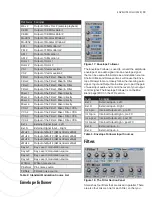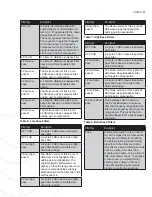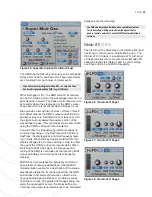
LFOS |
25
Figure 25: Super Modulation Oscillator Panel
The SMO has the following controls over the amplitude:
Delay Start, Fade In, and Fade Out. These parameters
are calculated from each note-on ( Gate) event.
Fade Out values must be greater than 0.00 – at zero, the Fade
Out circuit is ignored, and the SMO stays at full level.
When Retrigger is ‘On’, the SMO will start its modula-
tion from the same point in the waveshape every time a
gate signal is received. The Phase control allows you to
set exactly where the progression of the SMO’s wave-
shape will start (only functional when Retrigger is on).
Bias provides a list with two choices – Offset, or Recti-
fi
ed. Offset reduces the SMO’s output and shifts it into
positive values only; Recitifed does not reduce or shift
the signal, but only allows the positive portion of the
waveshape to pass. (This is perhaps more useful when
using the SMO as an audio rate modulator.)
You will notice the Frequency parameter changes its
controls, depending on the KeyTrack switch. Without
KeyTrack, the display gives a normal frequency read-
ing in Hertz. When the KeyTrack is switched ON, this
display changes to a Coarse and Fine tuning, to re
fl
ect
the use of the SMO as an audio rate oscillator. When
switching to MIDI Clock Sync, the Frequency and
tuning of the SMO is overridden by the incoming MIDI
signal, disabling and removing the other frequency
displays.
MIDI Clock Sync switches the frequency control to a
popup table of note values/divisions. See the MIDI
Implementation section for a description of the values.
Quantisation takes the incoming signal from the SMO
and divides it into discreet amounts, so that the con-
tinuous analog signal is ‘stepped’, providing a series
of pitches or notes. The greater the Range setting, the
wider the quantisation occurs; the Steps setting con-
trols how many semi-tone intervals are to be calculated
between each discrete step.
The SMO also has pink and white noise as possible selections
for its ‘waveshape’. Using noise obviously negates the fre-
quency controls, and in fact, only the SMO Level modulation is
relevant.
Vibrato LFO
(V-LFO)
The Vibrato LFO is dedicated to the vibrato effect and
has its own control area on Solaris’ Main page. The
Vibrato LFO in Solaris is a multimode LFO, with most
of the parameters that come with the multimode LFO
added: Delayed start (DelS), Fade In control, Retrig
and Phase options, and MIDI clockability.
Figure 26: Vibrato LFO Page 1
Figure 27: Vibrato LFO Page 2
Figure 28: Vibrato LFO Page 3
















































